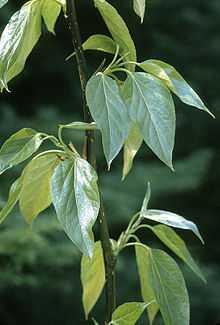Populus balsamifera
| Populus balsamifera Ontario Balsam Poplar | |
|---|---|
 | |
| Scientific classification | |
| Kingdom: | Plantae |
| (unranked): | Angiosperms |
| (unranked): | Eudicots |
| (unranked): | Rosids |
| Order: | Malpighiales |
| Family: | Salicaceae |
| Genus: | Populus |
| Section: | Tacamahaca |
| Species: | P. balsamifera |
| Binomial name | |
| Populus balsamifera L. | |
 | |
| Natural range | |
| Synonyms[1] | |
| |
Populus balsamifera, commonly called balsam poplar,[1] bam,[2] bamtree,[1] eastern balsam poplar,[1] hackmatack,[1] tacamahac poplar,[1] tacamahaca,[1] is a tree species in the balsam poplar species group in the poplar genus, Populus. The genus name Populus is from the Latin for poplar, and the specific epithet balsamifera from Latin for "balsam-bearing".[3] Other common names for the species include heartleaf balsam poplar, and Ontario balsam poplar.[citation needed] The black cottonwood, Populus trichocarpa, is sometimes considered a supspecies of P. balsamifera[4] and may lend its common name to this species, although the black poplars and cottonwoods of Populus sect. Aigeiros are not closely related.
Populus balsamifera is the northernmost American hardwood, growing transcontinentally on boreal and montane upland and flood plain sites, and attaining its best development on flood plains. It is a hardy, fast-growing tree which is generally short lived, but some trees as old as 200 years have been found.[5]
The Balm of Gilead (Populus × jackii), also known as P. × gileadensis, is the hybrid between P. balsamifera and the eastern cottonwood (P. deltoides), occurring occasionally where the two parental species' ranges overlap. This hybrid is also sometimes planted as a shade tree, and sometimes escapes from cultivation.[6] The name Populus candicans has been variously used for either P. balsamifera or P. × jackii; it is currently considered a synonym of P. balsamifera.
Balm of Gilead is a balm (healing compound) made from the resinous gum of this species[7] or related species such as Populus × jackii.[6] However, despite the name, this tree is not the source of the turpentine Canada balsam, derived instead from the balsam fir (Abies balsamea).
The light, soft wood of Populus balsamifera is used for pulp and construction.[5]
Many kinds of animals use the twigs of Populus balsamifera for food. The leaves of the tree serve as food for caterpillars of various Lepidoptera. See List of Lepidoptera that feed on poplars.
References
- ↑ 1.0 1.1 1.2 1.3 1.4 1.5 1.6 "USDA GRIN taxonomy".
- ↑ Peattie, Donald Culross. 1991. A Natural History of Trees of Eastern and Central North America. Boston: Houghton Mifflin Company, p. 100.
- ↑ Earl J.S. Rook (2006-03-04). "Balsam Poplar, Populus balsamifera". Rook.org. Retrieved 2012-08-30.
- ↑ "USDA PLANTS profile".
- ↑ 5.0 5.1 "Populus balsamifera L". Na.fs.fed.us. Retrieved 2012-08-30.
- ↑ 6.0 6.1 Werthner, William B. (1935). Some American Trees: An intimate study of native Ohio trees. New York: The Macmillan Company. pp. xviii + 398 pp.
- ↑ "Herbal Branch 4: Balm of Gilead". Familyherbalremedies.com. Retrieved 2012-08-30.
![]() Media related to Populus balsamifera at Wikimedia Commons
Media related to Populus balsamifera at Wikimedia Commons